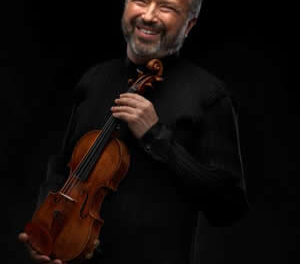Two young string players joined members of the Greensboro Symphony Orchestra and UNCG faculty to play a delightful chamber concert before a full house in the Recital Hall at UNCG’s School of Music. Cellist Julian Schwarz and violinist Stefani Collins, who were in town performing concerto rep with the GSO on Thursday and Saturday, played more intimate works by Debussy and Saint-Saëns, giving the listeners a picture of the French music world around the turn of the century on the Rice Toyota “Sitkovetsky & Friends” Chamber Series.
Schwarz and Collins, both 20-something, have local connections. The cellist’s father is Gerard Schwarz, the Music Director of the Eastern Music Festival, a professional and educational summer program now in its 49th season on the campus of Guilford College, and the violinist is the daughter of violinist Karen Collins, who is an active performer and teacher in Greensboro.
Claude Debussy (1862-1918) had originally planned to compose a set of six sonatas for different instruments late in his life; unfortunately, he completed only three. We heard two on Friday night: the Sonata for Cello and Piano and the Sonata for Violin and Piano, with Inara Zandmane at the keyboard. Both works are in three movements, but each displays a very different temperament.
Debussy stated that he wished to capture the spirit of Pierrot in his Cello Sonata. Much of the ill-fated harlequin’s character is easily discernable from the declamatory, mock-serious nature and the more tender moments of the Prologue through the mercurial pizzicatos of the Sérénade to the fanciful Finale.
The Violin Sonata, the last piece Debussy completed before dying, is a bit sparser and perhaps lighter in nature. The work is essentially a distillation of the composer’s style characteristics from lush “impressionistic” conjurings to virtuosity (especially from the piano) to colorful sonorities.
The performance of both sonatas displayed a perfect blend of fluidity and clear definition. The two soloists in each piece carved out distinct personalities. For Schwarz, the depressed but fanciful clown was poignantly projected, and Collins elicited finesse and grace. Zandmane was an equal partner in both, and her playing sparkled and provided solid support. Balance between the pianist and soloist was excellent, and ensemble was near-perfect.
Saint-Saëns Carnival of the Animals is the composer’s most famous work, a fact especially interesting since the composer forbade the score’s publication before he died. Perhaps Saint-Saëns was fearful that the public might remember him as a composer of the light and humorous rather than music more “serious” in intent. Be that as it may, this is great fun music.
Although not on the printed program, GSO Board of Directors member Ches Kennedy supplied Ogden Nash’s witty verses between each movement with appropriate feeling and dryness — the perfect addition to this very descriptive music of many animals.
Joining Kennedy, Collins and Schwarz were Zandmane and Vincent van Gelder (her husband) on pianos, Debra Pivetta (flute), Kelly Burke (clarinet), Wiley Sykes (percussion), Diane Phoenix-Neal (viola), John Spuller (bass), and GSO Music Director Dmitry Sitkovetsky (violin) in the lead position. It was a performance to be remembered, from the opening roar of the “Royal March of the Lion” to the concluding 14th movement, which brought back many of the tunes that were presented in between.
The composition is a colorful tour-de-force of musical depictions of animals. Especially notable were Spuller’s weighty solo in “The Elephant,” Pivetta’s acrobatic flute playing in “Aviary,” Sitkovetsky’s and Collins’ glissandos in “People with long ears,” Burke’s cuckooing in the movement of the same name, Sykes’ facile xylophone playing in “Fossils,” and Schwarz’s warm solo in the most famous movement, “The Swan.” One must also applaud Zandmane and van Gelder who had the lion’s share of the score; their playing of the Czerny-like “Pianists” movement was a showpiece of mock-pomp.











